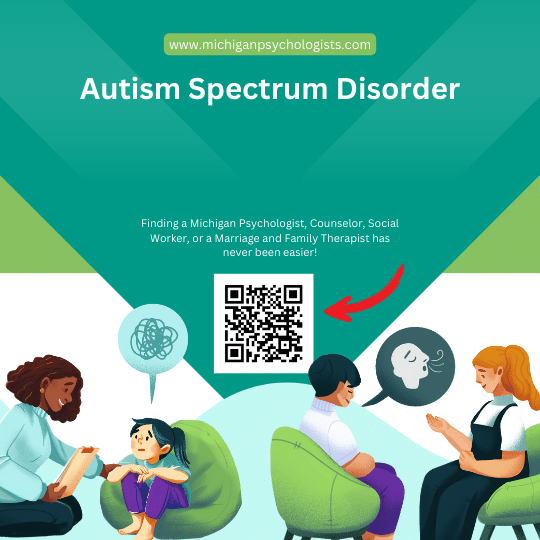Autism Spectrum Disorder
Home » Guide to DSM-5-TR Mental Health Disorders and Diagnostic Categories » Autism Spectrum Disorder

Table of Contents
Autism Spectrum Disorder (ASD) is a neurodevelopmental disorder characterized by persistent deficits in social communication and social interaction, along with restricted, repetitive patterns of behavior, interests, or activities. The DSM-5-TR categorizes ASD into three levels based on the severity of symptoms and the amount of support required.
Diagnostic Criteria
Persistent Deficits in Social Communication and Social Interaction
Individuals with ASD exhibit deficits in social-emotional reciprocity, such as abnormal social approach and failure to engage in back-and-forth conversation. They also demonstrate deficits in nonverbal communicative behaviors used for social interaction, including abnormalities in eye contact and body language. Additionally, individuals with ASD have deficits in developing, maintaining, and understanding relationships, such as difficulties in adjusting behavior to suit various social contexts.
Restricted, Repetitive Patterns of Behavior, Interests, or Activities
ASD is characterized by at least two of the following behaviors: stereotyped or repetitive motor movements, use of objects, or speech; insistence on sameness, inflexible adherence to routines, or ritualized patterns of verbal or nonverbal behavior; highly restricted, fixated interests that are abnormal in intensity or focus; and hyper- or hyporeactivity to sensory input or unusual interest in sensory aspects of the environment.
Symptoms Must Be Present in the Early Developmental Period
The symptoms of ASD typically manifest in the early developmental period but may not become fully apparent until social demands exceed the individual’s limited capacities. These symptoms cause clinically significant impairment in social, occupational, or other important areas of current functioning.
Symptoms Are Not Better Explained by Intellectual Disability or Global Developmental Delay
Intellectual Disability and ASD frequently co-occur, but the social communication deficits in ASD must be in excess of the intellectual developmental level.
Levels of Severity
Level 1: Requiring Support
Social Communication
Individuals at Level 1 exhibit noticeable deficits in social communication without supports in place. They may have difficulty initiating social interactions and demonstrate atypical or unsuccessful responses to social overtures from others. They may have decreased interest in social interactions and friendships, and their communication may be one-sided and atypical.
Restricted, Repetitive Behaviors
Inflexibility of behavior causes significant interference with functioning in one or more contexts. They may have difficulty switching between activities, problems with organization and planning, which hamper independence.
Level 2: Requiring Substantial Support
Social Communication
Marked deficits in verbal and nonverbal social communication skills are evident even with supports in place. Social impairments are noticeable even to a casual observer and limited initiation of social interactions occurs. Individuals at Level 2 may also exhibit reduced or abnormal responses to social overtures from others.
Restricted, Repetitive Behaviors
Inflexibility of behavior, difficulty coping with change, or other restricted/repetitive behaviors appear frequently enough to be obvious to the casual observer and interfere with functioning in a variety of contexts. Distress or difficulty changing focus or action is evident.
Level 3: Requiring Very Substantial Support
Social Communication
Severe deficits in verbal and nonverbal social communication skills cause severe impairments in functioning. Individuals at Level 3 very limited initiation of social interactions and minimal response to social overtures from others.
Restricted, Repetitive Behaviors
Inflexibility of behavior, extreme difficulty coping with change, or other restricted/repetitive behaviors markedly interfere with functioning in all spheres. Great distress/difficulty changing focus or action is present.
Associated Features
Intellectual and Language Impairments
Many individuals with ASD also have intellectual impairment and language impairments. Language abilities may range from absent to fully developed but atypical in terms of pragmatic use.
Medical and Genetic Conditions
A variety of medical and genetic conditions are associated with ASD. These include epilepsy, sleep disturbances, and gastrointestinal problems. Genetic syndromes such as Fragile X syndrome and Rett syndrome are also linked to ASD.
Behavioral and Emotional Challenges
Individuals with ASD may exhibit challenging behaviors such as aggression, self-injury, and tantrums. They may also experience co-occurring mental health issues such as anxiety, depression, and attention-deficit/hyperactivity disorder (ADHD).
Assessment and Diagnosis
Comprehensive Evaluation
Diagnosing ASD requires a thorough evaluation by a multidisciplinary team, including clinical observation, developmental history, and standardized assessments. The evaluation process should consider the individual’s cognitive, language, and adaptive functioning.
Differential Diagnosis
ASD must be differentiated from other developmental disorders, communication disorders, intellectual disabilities, and mental health conditions. Accurate diagnosis is essential for developing an effective intervention plan.
Intervention and Support
Early Intervention
Early intervention services can significantly improve outcomes for children with ASD. These services may include speech and language therapy, occupational therapy, and behavioral interventions.
Individualized Education Plans (IEPs)
For school-aged children, IEPs tailored to their specific needs can support educational and developmental progress. IEPs should include goals for social communication, adaptive behavior, and academic skills.
Behavioral Interventions
Behavioral interventions, such as Applied Behavior Analysis (ABA), are widely used to improve social, communication, and learning skills while reducing challenging behaviors.
Family Support and Education
Providing education and support to families is crucial. Families should be involved in intervention planning and have access to resources and support groups to help them navigate the challenges of raising a child with ASD.
Autism Spectrum Disorder, as described in the DSM-5-TR, encompasses a range of symptoms and severity levels. Understanding the diagnostic criteria, levels of severity, and associated features is essential for providing appropriate assessment and intervention. With early and targeted support, individuals with ASD can achieve significant improvements in communication, social interaction, and overall quality of life.